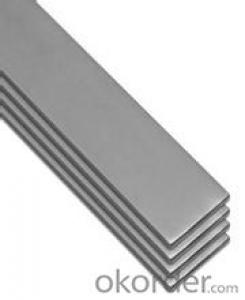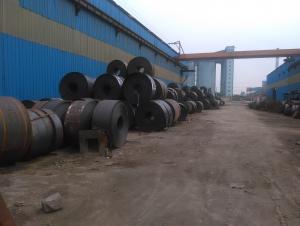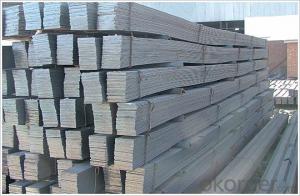Flat Steel High quality Hot rolled 20mm*3mm*6m
- Loading Port:
- Tianjin
- Payment Terms:
- TT or LC
- Min Order Qty:
- 25 m.t.
- Supply Capability:
- 12000 m.t./month
OKorder Service Pledge
OKorder Financial Service
You Might Also Like
Product Description:
OKorder is offering Flat Steel High quality Hot rolled 20mm*3mm*6m at great prices with worldwide shipping. Our supplier is a world-class manufacturer of steel, with our products utilized the world over. OKorder annually supplies products to European, North American and Asian markets. We provide quotations within 24 hours of receiving an inquiry and guarantee competitive prices.
Product Applications:
Flat Steel High quality Hot rolled 20mm*3mm*6m are ideal for structural applications and are widely used in the construction of buildings and bridges, and the manufacturing, petrochemical, and transportation industries.
Product Advantages:
OKorder's Flat Steel High quality Hot rolled 20mm*3mm*6m are durable, strong, and resist corrosion.
Main Product Features:
· Premium quality
· Prompt delivery & seaworthy packing (30 days after receiving deposit)
· Corrosion resistance
· Can be recycled and reused
· Mill test certification
· Professional Service
· Competitive pricing
Product Specifications:
Manufacture: Hot rolled
Grade: Q195 – 235
Certificates: ISO, SGS, BV, CIQ
Length: 6m – 12m, as per customer request
FAQ:
Q1: Why buy Materials & Equipment from OKorder.com?
A1: All products offered byOKorder.com are carefully selected from China's most reliable manufacturing enterprises. Through its ISO certifications, OKorder.com adheres to the highest standards and a commitment to supply chain safety and customer satisfaction.
Q2: How do we guarantee the quality of our products?
A2: We have established an advanced quality management system which conducts strict quality tests at every step, from raw materials to the final product. At the same time, we provide extensive follow-up service assurances as required.
Q3: How soon can we receive the product after purchase?
A3: Within three days of placing an order, we will begin production. The specific shipping date is dependent upon international and government factors, but is typically 7 to 10 workdays.
Q4: What makes stainless steel stainless?
A4: Stainless steel must contain at least 10.5 % chromium. It is this element that reacts with the oxygen in the air to form a complex chrome-oxide surface layer that is invisible but strong enough to prevent further oxygen from "staining" (rusting) the surface. Higher levels of chromium and the addition of other alloying elements such as nickel and molybdenum enhance this surface layer and improve the corrosion resistance of the stainless material.
Q5: Can stainless steel rust?
A5: Stainless does not "rust" as you think of regular steel rusting with a red oxide on the surface that flakes off. If you see red rust it is probably due to some iron particles that have contaminated the surface of the stainless steel and it is these iron particles that are rusting. Look at the source of the rusting and see if you can remove it from the surface.
Images:
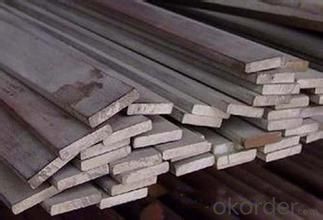
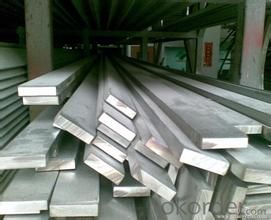
- Q:How do steel flat bars contribute to the overall stability of structures?
- Steel flat bars contribute to the overall stability of structures by providing structural support and resistance against bending and torsional forces. They are commonly used as beams, braces, and frames, helping to distribute the load evenly and prevent the structure from collapsing or deforming under various loads and external pressures. Their inherent strength, durability, and rigidity make them crucial components in reinforcing and enhancing the stability and integrity of different types of structures, including buildings, bridges, and industrial frameworks.
- Q:Can steel flat bars be used in the manufacturing of furniture?
- Yes, steel flat bars can be used in the manufacturing of furniture. Steel flat bars are strong and durable, making them suitable for creating sturdy furniture pieces. They can be used as support structures, frames, or as decorative accents in various types of furniture like tables, chairs, shelves, and cabinets. Steel flat bars can be easily shaped and welded to create customized furniture designs. Additionally, steel flat bars can be finished in different coatings, such as powder coating or galvanization, to enhance their appearance and protect against rusting. Overall, steel flat bars offer versatility and strength, making them a popular choice for furniture manufacturing.
- Q:Can steel flat bars be used for making agricultural equipment?
- Agricultural equipment can be made using steel flat bars. Steel, a durable and versatile material, is commonly used in constructing agricultural machinery. By shaping and welding steel flat bars, various components and structures required for agricultural equipment, such as plows, cultivators, and harrows, can be created. The robust and inflexible nature of steel flat bars makes them suitable for enduring the demanding conditions and pressures encountered in agricultural operations. Moreover, steel is resistant to corrosion and can withstand exposure to moisture and other elements commonly found in agricultural environments. In conclusion, steel flat bars are a popular choice for manufacturing agricultural equipment due to their strength, durability, and versatility.
- Q:Can steel flat bars be used in the manufacturing of HVAC systems?
- Certainly! HVAC systems can utilize steel flat bars in their manufacturing process. Steel is widely employed in HVAC systems owing to its robustness, durability, and ability to withstand corrosion. The utilization of steel flat bars extends to numerous HVAC components, including brackets, supports, and frames. These bars offer stability and bolster the system, guaranteeing its optimal operation. Furthermore, steel flat bars can be easily tailored and fabricated to meet precise design specifications, rendering them suitable for diverse HVAC system configurations.
- Q:Are steel flat bars available in different colors or coatings?
- No, steel flat bars are typically not available in different colors or coatings. Steel is typically left in its natural state, which is a dark gray or silver color. However, it is possible to apply coatings or finishes to steel flat bars for specific purposes such as protection against corrosion or to enhance its appearance. These coatings can include galvanized coatings, which provide a layer of zinc to protect against rust, or powder coatings, which can add a layer of color to the steel. However, these coatings are typically applied after the steel has been formed into the flat bar shape and are not readily available in a wide range of colors or finishes.
- Q:Can steel flat bars be used in the food industry?
- Steel flat bars can be used in the food industry, but there are certain considerations that need to be taken into account. Steel is a versatile and durable material, making it suitable for various applications, including the food industry. However, it is important to ensure that the steel used is food-grade or stainless steel to meet the industry's hygiene and safety standards. Food-grade stainless steel is commonly used in the food industry due to its corrosion resistance, easy cleaning properties, and ability to withstand high temperatures. It is non-reactive, meaning it does not interact with the food or alter its taste, making it ideal for food preparation surfaces, countertops, and equipment. Steel flat bars can be utilized in the food industry for a range of purposes, such as constructing food processing equipment, fabricating worktables, shelves, and racks, or as a structural component in food packaging machinery. However, it is crucial to ensure that the steel used is compliant with food safety regulations and guidelines, such as those set by the Food and Drug Administration (FDA) or the European Food Safety Authority (EFSA). Regular steel flat bars, which are not specifically designed for food industry applications, may not meet the necessary standards for cleanliness and hygiene. These bars might contain impurities, such as rust or contaminants, that could potentially contaminate the food or compromise its safety. Therefore, when considering the use of steel flat bars in the food industry, it is essential to select food-grade stainless steel that is specifically manufactured and designated for such applications. This will help ensure that the steel is safe, durable, and suitable for use in food processing, handling, and preparation areas.
- Q:Building poles, outdoor flat steel, the deeper the buried depth, the better?
- Building poles, outdoor flat steel, buried depth is not as deep as possible. According to the standard requirements, the level of the embedded depth is not less than 0.6 meters.
- Q:The difference between use and performance of hot rolled flat steel and longitudinally cut flat steel is discussed
- Its manufacturing process determines the poor dimensional accuracy of hot-rolled flat steel.Vertical shearing flat steel (fine shearing flat steel strip):The raw material board is produced by a larger factory, the raw material source is controllable, the material can be basically guaranteed, and the mechanical performance can basically meet the relevant GB standards.The dimension of vertical shear flat steel is relatively high.
- Q:Can steel flat bars be used for manufacturing automotive parts or components?
- Indeed, automotive parts or components can be manufactured using steel flat bars. In the automotive industry, steel flat bars find widespread use in diverse applications like brackets, supports, frames, and reinforcements. Due to steel's exceptional strength and durability, it stands as an ideal material for automotive manufacturing, capable of enduring the demanding loads and requirements of vehicles. Furthermore, steel flat bars offer ease of machining, welding, and shaping into various dimensions, providing flexibility and adaptability for the production of automotive components.
- Q:What are the different types of surface coatings available for steel flat bars?
- Steel flat bars can be coated with various types of surface coatings, each offering its own advantages and characteristics. 1. Galvanized Coating: Applying a layer of zinc to the steel flat bar surface is a commonly used coating. This coating provides excellent protection against corrosion and environmental factors, preventing rust. 2. Powder Coating: In this process, a dry powder is applied to the steel flat bar and then heated to create a durable coating. Powder coating is popular for both decorative and protective purposes due to its wide range of colors and finishes. 3. Epoxy Coating: Known for its strong adhesion and chemical resistance, epoxy coatings create a tough and durable layer on the steel flat bar. This makes them suitable for industrial applications in harsh environments. 4. Paint Coating: A cost-effective option for protecting steel flat bars, paint coatings come in various colors and finishes. They provide both aesthetic appeal and corrosion protection. 5. Anodized Coating: While commonly used on aluminum, anodizing can also be applied to steel flat bars. This process creates an oxide layer that enhances corrosion resistance and improves the appearance of the steel. 6. Chrome Plating: By depositing a layer of chromium onto the steel flat bar surface, chrome plating offers excellent hardness, wear resistance, and a polished appearance. 7. Phosphate Coating: Often used as a pre-treatment before painting or powder coating, phosphate coatings enhance the adhesion of subsequent coatings and provide additional corrosion resistance. When choosing the appropriate surface coating for steel flat bars, it is important to consider the specific requirements of your application. Factors such as corrosion resistance, durability, aesthetics, and cost should be taken into account to ensure the best choice for your needs.
1. Manufacturer Overview |
|
|---|---|
| Location | |
| Year Established | |
| Annual Output Value | |
| Main Markets | |
| Company Certifications | |
2. Manufacturer Certificates |
|
|---|---|
| a) Certification Name | |
| Range | |
| Reference | |
| Validity Period | |
3. Manufacturer Capability |
|
|---|---|
| a)Trade Capacity | |
| Nearest Port | |
| Export Percentage | |
| No.of Employees in Trade Department | |
| Language Spoken: | |
| b)Factory Information | |
| Factory Size: | |
| No. of Production Lines | |
| Contract Manufacturing | |
| Product Price Range | |
Send your message to us
Flat Steel High quality Hot rolled 20mm*3mm*6m
- Loading Port:
- Tianjin
- Payment Terms:
- TT or LC
- Min Order Qty:
- 25 m.t.
- Supply Capability:
- 12000 m.t./month
OKorder Service Pledge
OKorder Financial Service
Similar products
New products
Hot products
Related keywords
